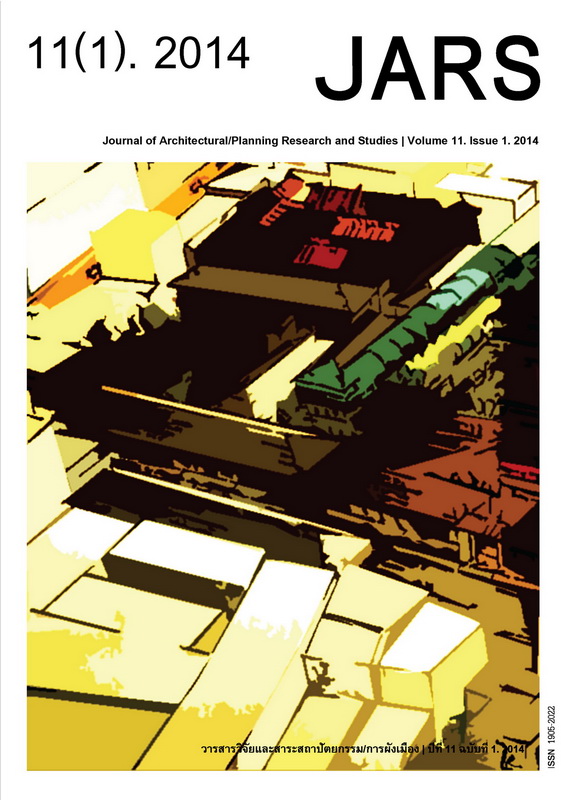Design Guideline of Office Building Facade with Self-Shading for Energy Conservation in Hot-Humid Climate
Main Article Content
Abstract
AbstractThis research aims at studying the solution for reducing energy consumption of an office building facade with self-shading applications. The four important design variables include orientations, extension self-shading length, Window to Wall Ratio (WWR) and automatic daylight dimmer. Using the simulation program called eQUEST-3.64. This study focuses on self-shading of facade with both single and multiple orientations with 4 variables including shading length, orientations, daylight dimmer, and applications comparison. For the shading length, the research results show that length of a self-shading facade affected the energy reduction most. Self-shading of 2.5 m can achieve the highest energy saving of wide WWR range from 20% - 100%. Also, the most feasible orientation of the self-shading facade is the east, while the north is not suitable for self-shading application. For the daylight dimmer, it can reduce the energy consumption by up to 12% when WWR is optimized. When comparing the self-shading with other applications including shading device and tilted wall, it is found that the self-shading at WWR 20% - 80% is the most efficient solution. Moreover, the energy saving extends greater if using self-shading facade is applied for multiple orientations. The results from this research are useful for architects who are interested in the facade design, and can effectively use self-shading facade to maximize energy conservation benefit.
Downloads
Article Details

This work is licensed under a Creative Commons Attribution-NonCommercial-NoDerivatives 4.0 International License.
All material is licensed under the terms of the Creative Commons Attribution 4.0 International (CC-BY-NC-ND 4.0) License, unless otherwise stated. As such, authors are free to share, copy, and redistribute the material in any medium or format. The authors must give appropriate credit, provide a link to the license, and indicate if changes were made. The authors may do so in any reasonable manner, but not in any way that suggests the licensor endorses you or your use. The authors may not use the material for commercial purposes. If the authors remix, transform, or build upon the material, they may not distribute the modified material, unless permission is obtained from JARS. Final, accepted versions of the paper may be posted on third party repositories, provided appropriate acknowledgement to the original source is clearly noted.
References
Anderson, B. (1977). Solar energy: Fundamentals in building design. Harrisville, New Hampshire: McGrew-Hill.
ASHRAE Standard 90.1 (2007). Energy standard for buildings except low-rise residential buildings (I-P edition).Atlanta: ASHRAE.
Capeluto, I.G. (2003). Energy performance of the self-shading building envelope. Energy and Buildings. Energy and Buildings, 35(3), 327-336.
Chaiwiwatworakul, P., & Rakkwamsuk, P. (2008). Energy conservation glass. Post Today, p. B6.
Laopanitchakul, V., & Srisutapan, A. (2007). ประสิทธิภาพของผนังไม้เลื้อยในการลดการถ่ายเทความร้อนผ่านผนังอาคาร[The performance of climbing-plant panel for reducing heat transfer through solid wall]. Journal of Architectural/Planning Research and Studies, 5(1), 173-183.
Lechner, N. (2009). Heating, cooling, lighting: Design methods for architects (2nd ed.). New York: John Wiley & Sons.
Luangcharoenrat, C., & Intrachooto, S. (2013). เกณฑ์การประเมินอาคารที่ยั่งยืน: ความเหมือน ความต่าง และค่าความสำคัญที่ให้ต่อสิ่งแวดล้อม ทรัพยากร และพลังงาน [A comparative study of green building evaluation standards: identifying major/minor emphasis on environment, resource and energy issues]. Journal of Architectural /Planning Research and Studies, 10(1), 1-18.
Ministry of Energy. (2011). Trend of electricity consumption in office building. Lecture Material: Author.
Moore, F. (1993). Environmental control system: Heating cooling lighting. New York: McGraw-Hill.
Nikpour, M., Kandar, M. Z., & Mosavi, E. (2012). Investigating daylight quality using self- shading strategy energy commission building in Malaysia. Indoor and Built Environment, 22(5), 822-835.
Nikpour, M., Kandar, M., Ghasemi, M., Ghomeshi, M., & Mohammad R. S. (2012). Heat transfer reduction using self shading strategy in energy commission building in Malaysia. Journal of Applied Sciences,12(9), 897-901.
Nittaya, S. (2002).การออกแบบอาคารสำหรับภูมิอากาศเขตร้อนชื้น [Tropical design environment] (2nd ed.). Bangkok, Thailand: Chulalongkorn University Press.
Varodompun, J., & Asavapitayanont, A. (2012). Design guidelines of the utilization of tilted facades to enhance building energy performance. Journal of Green Building, 7(1), 120-142.


